SMS Manuals and Programs

Professionally developed and ready for use with the OmniSMS web application.
Discover the power of structured event investigation, and how resulting data supports trend analysis, safety performance indicators, and quality / process performance measurements.

Event Investigation Guide
Identify Barriers, Contributing Factors and Root Causes
The OmniSMS Event Investigation Guide uses a systems approach to event investigation that goes beyond root cause analysis. By identifying existing barriers and controls that prevent minor reported events from escalating into incident / accident scenarios, a broader and more systemic picture of risk emerges, and the value of a barrier-based approach to safety management becomes clear.
Developed to work specifically with the OmniSMS web application, this Guide provides managers with tools that range from a simple 5-why analysis (for less complex events) to full-blown accident investigation using time-actor diagrams and event building blocks.
While most irregularities can be investigated using 5-why analysis, when systems break down and the outcome is an inflight occurrence or maintenance system failure, better investigative tools are needed.
Here’s a sample of the OmniSMS Event Investigation Guide (EIG), which supports managers in their investigations of:
- Incidents and near-accidents;
- Reported irregularities and audit findings;
- Nonconformances (including Mx QA and risk control nonconformances);
- Errors and violations (including ASAP reports).
Within OmniSMS, investigators first identify barriers that remained in place (including those contained in Flight Safety Foundation’s BAR standard). Then, when the causal factors of system failure are identified, they are associated with user-defined operational processes, departments, and external providers. As data is accumulated, trends in causal factors become readily apparent within these processes and departments, and risk is managed with external providers.
The same is true for quality nonconformances. For example, an installation or repair error can be analyzed to better understand the barriers that worked; in other words, those safety and quality controls in place that prevented the error from becoming an inflight system or component failure. And if a failure should occur in flight, the same process is used to analyze 1) the barrier that prevented escalation of the event into an accident; and 2) the barriers that remained in place. Root cause analysis is then performed to identify the barriers that failed, as well as the numerous human and organizational factors that led to the event.
Improve your investigation results with the OmniSMS Event Investigation Guide.
